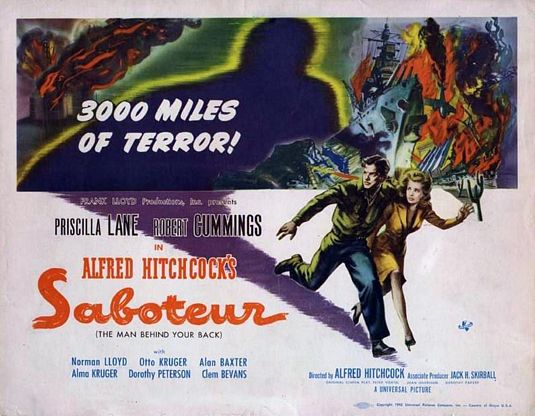Introduction:
“Saboteur” (1942), directed by the master of suspense Alfred Hitchcock, stands as a remarkable entry in the annals of classic cinema. This World War II-era thriller, infused with mystery and espionage, showcases Hitchcock’s storytelling prowess and innovative filmmaking techniques. In this comprehensive review, we will explore the narrative intricacies, character dynamics, cinematic brilliance, and enduring legacy of “Saboteur,” shedding light on its place in Hitchcock’s illustrious filmography.
Plot Synopsis:
Set against the backdrop of a wartime America, “Saboteur” follows the story of Barry Kane, played by Robert Cummings, a factory worker wrongly accused of sabotage after an explosion at an aircraft plant. Determined to clear his name, Kane embarks on a cross-country journey to expose the real saboteur. Along the way, he encounters a diverse array of characters, including the enigmatic Patricia Martin, portrayed by Priscilla Lane. The plot unfolds with a series of thrilling events, espionage, and unexpected alliances, leading to a climactic showdown atop the iconic Statue of Liberty.
Character Dynamics:
“Saboteur” presents a rich tapestry of characters, each contributing to the film’s suspenseful atmosphere and Hitchcock’s exploration of mistaken identity. Robert Cummings delivers a compelling performance as Barry Kane, the wrongly accused protagonist driven by a relentless pursuit of justice. Priscilla Lane’s Patricia Martin provides a complex and unpredictable counterpart, blurring the lines between ally and adversary. The ensemble cast, featuring Norman Lloyd as the sinister Frank Fry and Otto Kruger as the mysterious Charles Tobin, adds layers of intrigue to the narrative.
Cinematic Brilliance:
Hitchcock’s directorial brilliance shines through in “Saboteur,” showcasing his ability to craft suspenseful narratives and employ innovative cinematic techniques.
- High-Stakes Thrills:
- “Saboteur” masterfully builds tension through its high-stakes scenarios. From the riveting opening scene at the aircraft plant to the climactic confrontation atop the Statue of Liberty, Hitchcock keeps the audience on the edge of their seats with a series of heart-pounding moments.
- Masterful Set Pieces:
- The film features several masterful set pieces, including the iconic sequence at the Radio City Music Hall and the memorable escape through the rural circus. Hitchcock’s meticulous attention to detail and flair for creating suspenseful environments elevate these scenes, making them stand out as classic moments in cinematic history.
- Mistaken Identity Theme:
- “Saboteur” explores the theme of mistaken identity, a recurring motif in Hitchcock’s works. The film delves into the consequences of being falsely accused and the challenges faced by the protagonist as he navigates a world where trust is a scarce commodity.
- Visual Storytelling:
- Hitchcock employs visual storytelling techniques to convey narrative nuances. The use of shadows, camera angles, and framing contributes to the film’s atmospheric tension, heightening the viewer’s engagement with the unfolding mystery.
Enduring Legacy:
While “Saboteur” may not be as celebrated as some of Hitchcock’s more iconic films, its enduring legacy lies in its contribution to the director’s exploration of suspense and espionage during a critical period in history. The film captures the zeitgeist of World War II-era America while providing a template for Hitchcock’s later espionage-themed works.
Critical Reception and Contemporary Perspectives:
“Saboteur” received positive reviews upon its release, with critics praising its thrilling narrative and Hitchcock’s adept direction. In contemporary analysis, the film is acknowledged for its role in shaping the wartime thriller genre and showcasing the director’s evolving narrative techniques.
Conclusion:
“Saboteur” (1942) stands as a testament to Alfred Hitchcock’s ability to weave suspenseful tales within the complex tapestry of mistaken identity and wartime intrigue. Its enduring appeal lies in the masterful combination of a gripping narrative, memorable characters, and innovative cinematic techniques. While it may not hold the same iconic status as some of Hitchcock’s later works, “Saboteur” remains a captivating journey into the world of wartime suspense cinema. As an integral piece in Hitchcock’s filmography, it deserves recognition for its contribution to the director’s exploration of suspense, espionage, and the enduring battle between innocence and suspicion.
